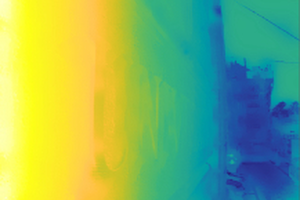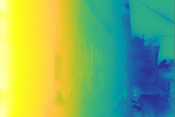Information
- Publication Type: Conference Paper
- Workgroup(s)/Project(s):
- Date: January 2021
- ISBN: 978-1-7281-8809-6
- Publisher: IEEE
- Open Access: yes
- Location: Milan, Italy
- Lecturer: Joao Afonso Cardoso
- Event: 25th International Conference on Pattern Recognition (ICPR)
- DOI: 10.1109/ICPR48806.2021.9412730
- Call for Papers: Call for Paper
- Booktitle: Proceedings of the 25th International Conference on Pattern Recognition
- Conference date: 10. January 2021 – 15. January 2021
- Pages: 354 – 361
- Keywords: depth reconstruction, light fields, cost volumes
Abstract
Light-field cameras are becoming more popular in the consumer market. Their data redundancy allows, in theory, to accurately refocus images after acquisition and to predict the depth of each point visible from the camera. Combined, these two features allow for the generation of full-focus images, which is impossible in traditional cameras. Multiple methods for depth prediction from light fields (or stereo) have been proposed over the years. A large subset of these methods relies on cost-volume estimates – 3D objects where each layer represents a heuristic of whether each point in the image is at a certain distance from the camera. Generally, this volume is used to regress a depth map, which is then refined for better results. In this paper, we argue that refining the cost volumes is superior to refining the depth maps in order to further increase the accuracy of depth predictions. We propose a set of cost-volume refinement algorithms and show their effectiveness.Additional Files and Images
Weblinks
BibTeX
@inproceedings{cardoso-2021-cost,
title = "Cost Volume Refinement for Depth Prediction",
author = "Joao Afonso Cardoso and Nuno Goncalves and Michael Wimmer",
year = "2021",
abstract = "Light-field cameras are becoming more popular in the
consumer market. Their data redundancy allows, in theory, to
accurately refocus images after acquisition and to predict
the depth of each point visible from the camera. Combined,
these two features allow for the generation of full-focus
images, which is impossible in traditional cameras. Multiple
methods for depth prediction from light fields (or stereo)
have been proposed over the years. A large subset of these
methods relies on cost-volume estimates – 3D objects where
each layer represents a heuristic of whether each point in
the image is at a certain distance from the camera.
Generally, this volume is used to regress a depth map, which
is then refined for better results. In this paper, we argue
that refining the cost volumes is superior to refining the
depth maps in order to further increase the accuracy of
depth predictions. We propose a set of cost-volume
refinement algorithms and show their effectiveness.",
month = jan,
isbn = "978-1-7281-8809-6",
publisher = "IEEE",
location = "Milan, Italy",
event = "25th International Conference on Pattern Recognition (ICPR)",
doi = "10.1109/ICPR48806.2021.9412730",
booktitle = "Proceedings of the 25th International Conference on Pattern
Recognition",
pages = "354--361",
keywords = "depth reconstruction, light fields, cost volumes",
URL = "https://www.cg.tuwien.ac.at/research/publications/2021/cardoso-2021-cost/",
}


 amended-paper
amended-paper

